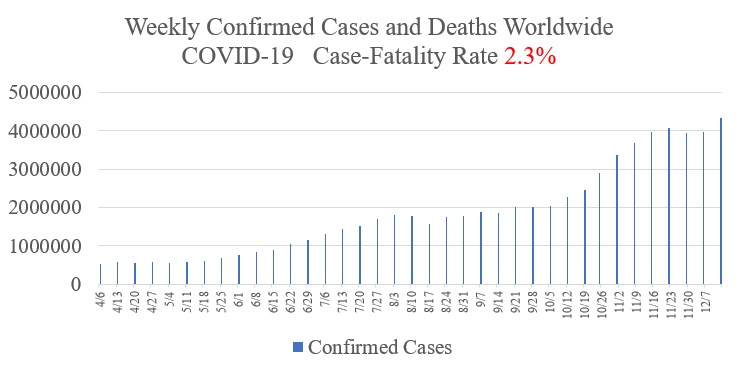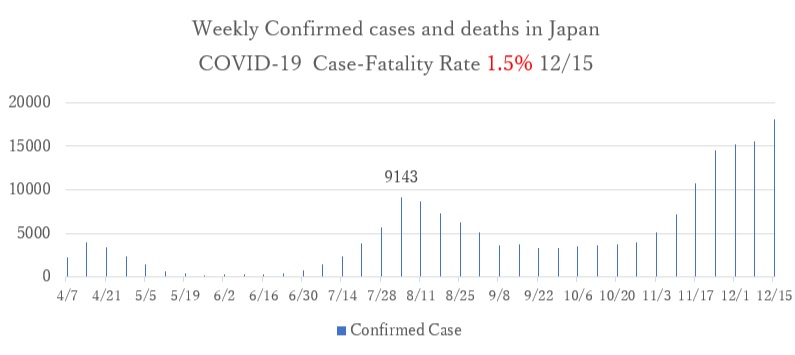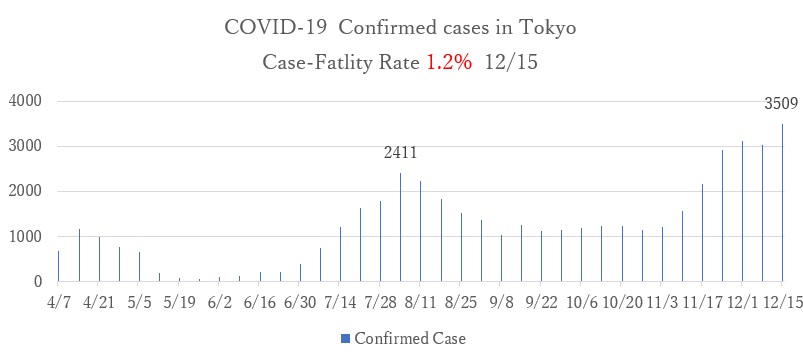SHARE
Services for the Health in Asian & African Regions (SHARE) = SHARE is a citizen sector organization (NGO) that engages in international cooperation mainly through providing health service.
HOME > News > Information of COVID-19(14)
- 【※updated】COVID-19(multi-language)
- Information of COVID-19(15)
- Information of COVID-19(vaccines)
- 《Request to the Government of Japan》Ease the protection of intellectual property rights and promote sharing and cooperating on pharmaceuticals and medical technologies, in order to accelerate efforts to overcome COVID-19 all over the world.
- Information of COVID-19(14)
- Information of COVID-19(13)
- Information of COVID-19(12)
- Information of COVID-19(11)
- SHARE Medical Information Line for Migrants is resumed in Oct.
- Information of COVID-19(10)
Information of COVID-19(14)

Information of COVID-19 (14)by SHARE 2020.12.20
1. Global and Japanese Situation regarding COVID-19
■Confirmed cases and new deaths from COVID-19 worldwide(source: WHO, updated 2020/12/13)Case fatality rate:2.3%

- With approximately 4.3 million new positive cases and over 75,000 new deaths per week worldwide, the COVID-19 epidemic is growing. The case-fatality rate is 2.3%. The total number of positive cases has exceeded 70 million and the number of deaths has reached 1.6 million. (WHO, updated 2020/12/13)
- The four countries that have reported the most cases worldwide in the past month are the U.S., Brazil, India, and Russia. The U.S. is experiencing a particularly high rate of increase, with more than 200,000 new positive cases being identified every day.
- In the African region, the epidemic is coming back, with notable increases of COVID-19 cases in Mali, Nambia, Nigeria, Senegal, and South Africa.
- In the Eastern Mediterranean and European regions, the number of cases is on a downward trend.
- The Southwest Asia region has seen a downward trend in the number of cases as the rate of increase in india, the largest endemic country in the region, has decreased.
- In the Western Pacific region, the number of cases is on the rise, especially in Japan, although its share in the global cases is small.
■Weekly confirmed cases and deaths of COVID-19 in Japan (Updated 2020/12/8)
- Case fatality rate 1.5%

■Weekly confirmed cases of COVID-19 in Tokyo (Updated 2020/12/8)
- Case fatality rate 1.2%

- The number of new positive cases in Tokyo is reaching 300-500 daily, suggesting that the epidemic is continuing. There is an increasing trend in the Tokyo metropolitan area, Aichi Prefecture, Osaka, Kyoto, Hyogo, Fukuoka, and other large regional cities, suggesting that the epidemic is continuing nationwide.
2. Vaccination and Immunity
- It was reported that patients infected and symptomatic with SARS-CoV-2 may remain immune to the virus for at least six months afterwards. This suggests that the effect of vaccination lasts as long as natural immunity.
- On the other hand, Imperial College London, a British university, announced the results of a study that showed even after people recover after being infected, their antibodies rapidly decrease within three months. "Herd immunity," the ability to contain the infection by allowing most of the population to become infected, recover and build immunity, may not be possible with this virus.
- Vaccination is expected to prevent COVID-19, however it is necessary to ensure the safety of vaccination. If the rate of side effects is high or there are serious adverse events like death, the vaccine is not suitable for public use.
- With multiple vaccines being developed (six deployed in humans as of December 15, including from the U.S., U.K., China, and Russia) simultaneously, there is a good chance that a vaccine will be found that suits each individual.
- The UK's Medicines and Healthcare products Regulatory Agency (MHRA) has announced that people who have had anaphylactic reactions to medicines or foods should not be vaccinated with the Pfizer COVID-19 vaccine.
- On December 13, clinical trials of a vaccine developed by Sinopharm, a major Chinese pharmaceutical company, were temporarily suspended in Peru because one subject showed neurological symptoms.
・"An mRNA Vaccine against SARS-CoV-2 -- Preliminary Report"
・"Is the fast-developed COVID-19 vaccine more dangerous than the virus?"
・"COVID-19 Vaccine Adverse Reactions to be Reviewed by Each Country: WHO Peru cancels clinical trial of Chinese-made vaccine for neurological symptoms."
3. Characteristics of COVID-19 patients
This is a summary of the symptoms, course, and severity of COVID-19 that have been raging around the world in 2020. We now know about the after effects, which were not known in the early stages of the pandemic.- The incubation period for the virus ranges from 1 to 14 days, and most people develop the disease in about 4 to 5 days. Symptoms are similar to those of colds and influenza, including cough, shortness of breath, difficulty breathing, fever, chills, muscle pain, joint pain, vomiting, diarrhea, and abnormal sense of smell and taste. In particular, shortness of breath, olfactory and taste disturbance are rare symptoms in colds and influenza, which may trigger suspicion of coronavirus infection.
- Symptoms such as fever and cough accompany olfactory and taste disturbances increase the likelihood of COVID-19, although similar conditions can also be seen with colds, sinusitis, and hay fever.
- According to data from 40,000 infected people in China during the early stage of the epidemic, the initial onset of the disease is followed by minor symptoms like a cold for about a week, and about 80% of the people recover without any symptoms, but less than 20% become seriously ill.
- From the data collected in Japan since June, elderly people and patients with chronic illnesses are most likely to become seriously ill from COVID-19. The rate of people who become seriously ill is about 1.6% (0.3% in those under 50 and 8.5% in those of 60 and over), and the mortality rate is about 1.0% (0.06% in those under 50 and 5.7% in those of 60 and over). The severity of the disease is reportedly higher in males than in females.
- It has been reported that about 30-40% of people infected with COVID-19, especially young people, are asymptomatic. For example, in a cluster of young people on the U.S. nuclear-powered aircraft carrier USS Theodore Roosevelt, 1,271 of the 4,779 crew members tested positive by PCR, of which 45% were asymptomatic at the time of testing, 32% were asymptomatic and later developed symptoms, and 23% were symptomatic.
- The most infectious period is considered to be from two days before to seven to ten days after the onset of the disease. Viral shedding is thought to be particularly high just before and after disease onset.
- The severity of the disease has been found to vary depending on a patient's pre-existing conditions. In the U.S., the risk of hospitalization is 1.5 times higher for asthma, 3 times for hypertension, 3 times for obesity (BMI >30), 3 times for diabetes, 4 times for chronic kidney disease, 4.5 times for severe obesity (BMI >40), 4.5 times for two underlying diseases, and 5 times for infected individuals with three or more comorbidities.
- In Japan, 10-20% of patients continue to have sequelae such as cough, phlegm, lethargy, dyspnea, olfactory disturbance, and taste disorder as long as 60 days after onset of the disease, and 2-11% have these sequelae 120 days after initial onset.
- In France, hair loss, memory impairment, sleep disturbance and poor concentration, have been reported as sequelae.
・"Symptoms, course and risk of severe COVID-19, and guidelines for seeking medical attention"
・Ministry of Health, Labour and Welfare, "10 Knowledge Points on the Present State of COVID-19"
Written by Nakasa T, MD, Co-President of SHARE
■【Release】Information of COVID-19(ENGLISH)
■Useful URLs by multi-languages




